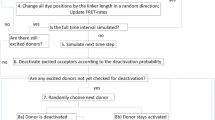Abstract
Fluorescence resonance energy transfer (FRET) is a popular tool to study equilibrium and dynamical properties of polymers and biopolymers in condensed phases and is now widely used in conjunction with single molecule spectroscopy. In the data analysis, one usually employs the Förster expression which predicts (l/R 6) distance dependence of the energy transfer rate. However, critical analysis shows that this expression can be of rather limited validity in many cases. We demonstrate this by explicitly considering a donor-acceptor system, polyfluorene (PF6)-tetraphenylporphyrin (TPP), where the size of both donor and acceptor is comparable to the distance separating them. In such cases, one may expect much weaker distance (as l/R 2 or even weaker) dependence. We have also considered the case of energy transfer from a dye to a nanoparticle. Here we find l/R 4 distance dependence at large separations, completely different from Förster. We also discuss recent application of FRET to study polymer conformational dynamics.
Similar content being viewed by others
References
Förster Th 1948Ann. Phys. (Leipzig) 2 55
Förster Th 1965 inModern quantum chemistry, istanbul lectures, Part III: Action of light and organic crystals (ed.) O Sinanoglu (New York: Academic Press) pp 93–137
Perrin J 1927C. R. Acad. Sci. (Paris) 184 1097
Scholes G D 2003Annu. Rev. Phys. Chem. 54 57
Lakowicz J R 1983Principles of fluorescence spectroscopy (New York: Plenum)
Deniz A A, Dahan M, Grunwell J R, Ha T, Faulhaber A E, Chemla D S, Weiss S and Schultz P G 1999Proc. Natl. Acad. Sci. USA 96 3670
Schuler B, Lipman E A and Eaton W A 2002Nature (London) 419 743
Struck D K, Hoeskstra D and Pagano R E 1981Biochemistry 20 4093
Dumas F, Sperotto M M, Lebrun M C, Tocanne T F and Mouritsen O G 1997Biophys. J. 73 1940
Clegg R M, Murchie A I H, Zechel A and Lilley M J 1993Proc. Natl. Acad. Sci. USA 90 2994
Issac V E, Patel L, Curran T and Abate-Shen C 1995Biochemistry 34 15276
Srinivas G and Bagchi B 2001J. Phys. Chem. B105 2475
Srinivas G and Bagchi B 2002J. Chem. Phys. 116 837
Murphy M C, Rasnik I, Cheng W and Ha T 2004Biophys. J. 86 2530
Orritt M 1999Science 285 349, and references therein
Tasch S, List E J W, Hochfilzer C, Leising G, Schlichting P, Rohr U, Geerts Y, Scherf U and Mullen K 1997Phys. Rev. B56 4479
Hu B, Zhang N and Karasz F E 1998J. Appl. Phys. 83 6002
Fox M A 1999Acc. Chem. Res. 32 201, and references therein
Nguyen T, Wu J, Doan V, Schwartz B J and Tolbert S H 2000Science 288 652
Wong K F, Bagchi B and Rossky P J 2004J. Phys. Chem. A108 5752
Yun C S, Javier A, Jennings T, Fisher M, Hira S, Peterson S, Hopkins B, Reich N O and Strouse G F 2005J. Am. Chem. Soc. 127 3115
Chance R R, Prock A and Silbey R 1978Adv. Chem. Phys. 37 1
Persson B and Lang N 1982Phys. Rev. B26 5409
Dulkeith E, Morteani A C, Niedereichholz T and Feldmann J 2002Phys. Rev. Lett. 89 203002
Wang L, Yan R, Huo Z, Wang L, Zeng J, Bao J, Wang X, Peng Q and Li Y 2005Angew. Chem. Int. Ed. 44 6054
Singh H and Bagchi B 2005Curr. Sci. 89 1710
Dexter D L 1953J. Chem. Phys. 21 836
Yang M and Fleming G R 2002Chem. Phys. 55 457
Author information
Authors and Affiliations
Corresponding author
Additional information
Dedicated to Prof J Gopalakrishnan on his 62nd birthday.
Rights and permissions
About this article
Cite this article
Saini, S., Singh, H. & Bagchi, B. Fluorescence resonance energy transfer (FRET) in chemistry and biology: Non-Förster distance dependence of the FRET rate. J Chem Sci 118, 23–35 (2006). https://doi.org/10.1007/BF02708762
Issue Date:
DOI: https://doi.org/10.1007/BF02708762




